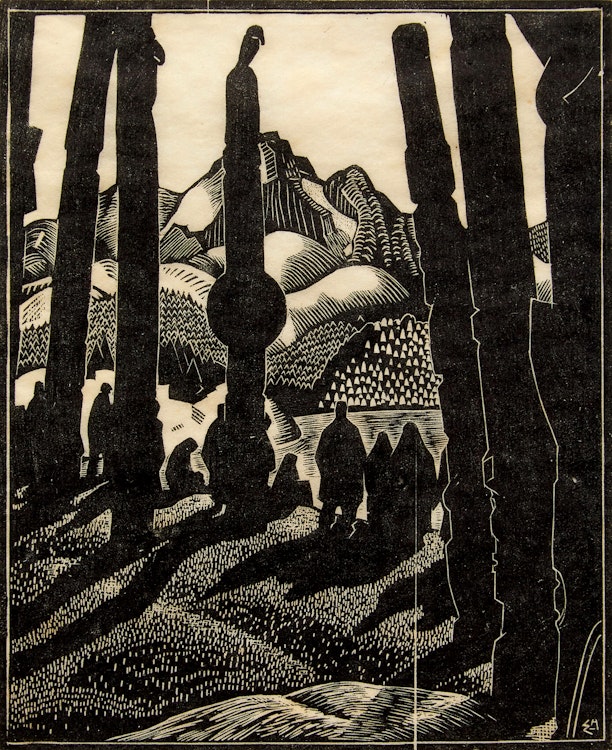Totem Poles, No. 4 (Departing People) by Edwin Headley Holgate

Edwin Holgate
Totem Poles, No. 4 (Departing People)
woodcut
signed lower right; dated 1926 on a gallery label on the reverse
5.75 x 4.75 ins ( 14.6 x 12.1 cms ) ( plate size )
Auction Estimate: $5,000.00 - $7,000.00
Price Realized $4,720.00
Sale date: September 24th 2020
Galerie Valentin, Montreal
Private Collection, Montreal
Rosalind Pepall and Brian Foss, “Edwin Holgate”, Montreal Museum of Fine Arts, 2005, illustrated page 58, cat. no. 160
to British Columbia along with his friend A.Y Jackson and the anthropologist Marius Barbeau. The group visited Gitxsan territory on the Skeena River, sketching totem poles and First Nations villages in the region. Barbeau emphasized the potency of the totem pole as a Canadian symbol, and Holgate depicted the iconic artifacts repeatedly in his paintings and prints.
“Totem Poles, No. 4 (Departing People)”, was created as part of a series of eight woodblock prints based on the excursion. Holgate presents the totems in silhouette, dramatizing their presence with outlines and solid, black forms. The figures standing on the shore echo the totems, and their postures and deep shadows add a sense of melancholy to the image. Their simplified forms are contrasted with the detailed, undulating landscape. Holgate taught wood engraving at the École des beaux-arts in Montréal, attracting praise and notoriety for his influential print work.
Share this item with your friends
Edwin Headley Holgate
(1892 - 1977) Group of Seven, Canadian Group of Painters, Beaver Hall Group, RCA
Edwin Holgate was born in Allandale, Ontario. Holgate began his art education at the Art Association of Montreal studying under William Brymner who was also A.Y. Jackson's teacher. In 1912 he went to Paris where he studied at the Académie de la Grande Chaumière under Claudio Castelucho and later under Lucien Simon and René Ménard. He was in Russia at the outbreak of the First World War. He returned to Canada where he enlisted and served with the 5th Canadian Division Artillery in France (1916-19). He married Mary Frances Rittenhouse in 1920 and returned to Paris where he continued his studies. There he attended the Colarossi under Adolph Milman, a Russian refugee.
He returned with his wife to Canada in 1922 and opened a studio. He taught wood engraving at the Ecole des Beaux Arts for six years. In Montreal he enjoyed the friendship of A.Y. Jackson, Clarence Gagnon, Mabel May, Lilas Newton, Randolph Hewton, and many of the younger artists who became known as the Beaver Hall Hill Group. Holgate was a good skier and he would take trips to various parts of Quebec to sketch during the winters, sometimes at Baie St. Paul where A.Y. Jackson, Clarence Gagnon, Mabel May and others would congregate.
In 1926 he accompanied A.Y. Jackson and Marius Barbeau to the Skeena River area in British Columbia. Barbeau had been investigating the condition of the Indian totem poles, many of which were restored by the C.N.R. engineer Mr. T.B. Campbell. Holgate and Jackson made a number of sketches of the poles and the Indian villages in the area. From his sketches, Holgate made several large canvases. One is in the collection of the National Gallery and entitled is “Totem Poles, Gitsegiuklas”.
Holgate became the eighth member of the Group of Seven in 1931 and remained a member of the Group until it disbanded in 1933. From it arose the Canadian Group of Painters of which he was a founding member. Paul Duval noted that Holgate and Varley were the only members of the Group who drew and painted nudes. Holgate was well known also for his portraits and did many striking character studies of inhabitants of Canadian bush country. The Art Gallery of Ontario and the National Gallery of Canada have his nude studies in their collections.
During the Second World War, Holgate served overseas as an official Canadian war artist with the R.C.A.F. and painted mainly portraits of flying officers. Holgate’s wood-engravings are exceptionally well done and interesting. He was a member of the Royal Canadian Academy (A.R.C.A. 1934 - R.C.A. 1935). His work has been exhibited in many group shows over the years. He is represented in many collections including the National Gallery of Canada, the Art Gallery of Ontario, the Art Gallery of Hamilton and the McMichael Collection.
Source: "A Dictionary of Canadian Artists, Volume II”, compiled by Colin S. MacDonald, Canadian Paperbacks Publishing Ltd, Ottawa, 1979

